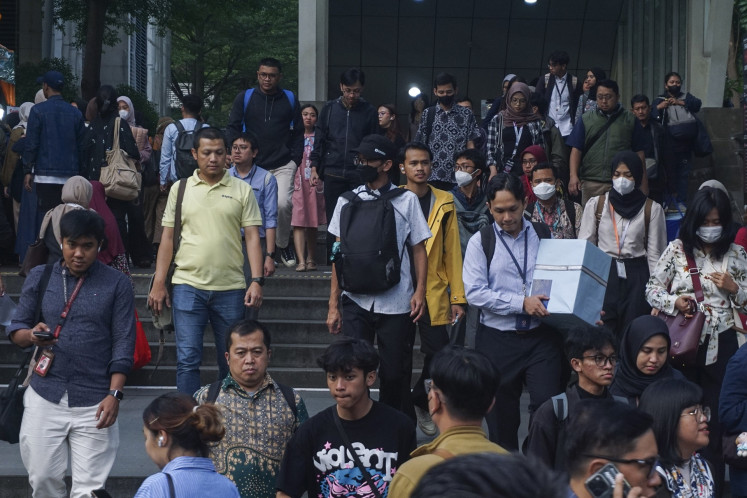Popular Reads
Top Results
Can't find what you're looking for?
View all search resultsPopular Reads
Top Results
Can't find what you're looking for?
View all search resultsChinese hungry to travel
Change text size
Gift Premium Articles
to Anyone
Over the recent Spring Festival holiday, Chinese visitors went to 730 cities across 68 countries and regions.
Chinese travelers are making their presence felt around the globe. They were expected to pay 6.5 million visits abroad over the recent Spring Festival holiday, and their footprints could be found in 730 cities across 68 countries and regions worldwide, the China National Tourism Administration reports.
Last year, the Chinese paid more than 130 million visits outside the mainland, representing a year-on-year growth of 7 per cent, according to China Tourism Academy.
Southeast Asia has seen the most visits by Chinese travellers with Thailand, Singapore, Malaysia and Indonesia among the most popular destinations.
Thailand received 9.8 million visits by the Chinese in 2017, according to Thailand’s Ministry of Tourism and Sports. Visitor numbers reached 313,000 during Spring Festival, a rise of 24.4 per cent over the same period last year.
Meanwhile, an increasing number of Chinese are warming up to long-distance travel destinations.
France, Germany, Switzerland and Italy have all seen a sizeable influx of Chinese visitors, many of whom go sightseeing on the Danube and the Rhine.
Read also: Chinese tourists' favorite places in Indonesia
Countries that used to be considered not so popular, such as Luxembourg, Monaco and Andorra, are also gaining ground with sophisticated travellers.
At the same time, countries and regions involved in the Belt and Road Initiative are also drawing Chinese travellers.
The number of Chinese visitors to countries such as the United Arab Emirates and Cambodia grew by 16 per cent during the holiday, according to a report by China UnionPay.
Currently, nearly 129 million Chinese have passports, and the number is growing, says the Ministry of Public Security.
Chinese travellers have also become the top spenders over the years, and accounted for approximately one fifth of the total consumption by global outbound travellers, according to the United Nations World Tourism Organization.
Chinese travellers spent $261 billion abroad in 2016, $11 billion more than 2015.
US travellers ranked second, and their consumption was half the Chinese spending.
Chinese travellers spent $541.4 million during Spring Festival, up 34.3 per cent year-on-year.
But despite the top-spender tag, many Chinese now pay more attention to catering and recreational activities, says the China UnionPay report.
Chinese spending on recreation in Europe grew more than 20 per cent year-on-year during the Spring Festival holiday.
And the Chinese are developing an appetite for tours featuring health preservation and culture and art appreciation, while earlier, they used to predominantly opt for shopping for luxury goods and sightseeing, says Zhang Yuhong, an official with the China Travel Service.
Self-drive tourism abroad is also becoming a big hit with Chinese travellers, half of whom were born in the mid-1980s and '90s, as shown by bookings through China’s biggest online travel agency Ctrip.
The Chinese travel boom has prompted the host destinations to come up with new facilities for their guests.
Read also: China to release do's and don'ts as more Chinese tourists visit Antarctica
For instance, Dubai has rolled out its China Ready programme, where Chinese-language services at local restaurants, hotels and scenic spots are readily available.
The city received 764,000 visitors from China last year, a jump of 41 per cent over the previous year, after it began offering free visas on arrival to Chinese citizens.
Separately, Indonesia has come up with a “10 Bali islands” plan, which includes infrastructure development, from Sumatra in the west to Maluku in the east.
In addition, several Southeast Asian countries plan to spend more than $100 billion to build airports, railway lines, hotels and theme parks to beef up facilities for Chinese visitors, the Singapore-based Lianhe Zaobao reports.
Thailand will work with Japan to build a high-speed rail line connecting Bangkok and Chiang Mai, while Malaysia wants to build rail lines to boost tourism development along its east coast.
Japan now not only has Chinese tour and shopping guide services at its major scenic spots, but also provides the mobile phone-based Alipay option for its Chinese guests.
More than 40,000 shops in the country, including Lawson and Don Quijote, support the payment method favoured by Chinese travellers.
In Europe, Italy has put up Chinese signage at its major airports and train stations. The country has developed wedding and sport-themed travel attractions tailored to Chinese tastes.
“China’s outbound tourism has become a strong engine for the world’s tourism economy, and plays a positive role in improving the employment and economic potential of the destination countries,” says Li Xinjian, head of the tourism management institute at the Beijing International Studies University.
Shi Peihua, an official with a China travel think tank, says that with China’s reform and opening-up policy, China’s outbound tourism will continue to grow.







